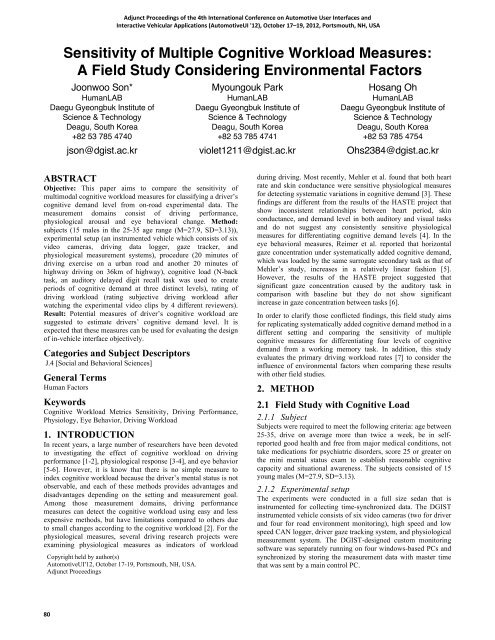12: Adjunct Proceedings - Automotive User Interfaces and ...
12: Adjunct Proceedings - Automotive User Interfaces and ...
12: Adjunct Proceedings - Automotive User Interfaces and ...
You also want an ePaper? Increase the reach of your titles
YUMPU automatically turns print PDFs into web optimized ePapers that Google loves.
Sensitivity of Multiple Cognitive Workload Measures:<br />
A Field Study Considering Environmental Factors<br />
Joonwoo Son*<br />
HumanLAB<br />
Daegu Gyeongbuk Institute of<br />
Science & Technology<br />
Deagu, South Korea<br />
+82 53 785 4740<br />
json@dgist.ac.kr<br />
ABSTRACT<br />
Objective: This paper aims to compare the sensitivity of<br />
multimodal cognitive workload measures for classifying a driver’s<br />
cognitive dem<strong>and</strong> level from on-road experimental data. The<br />
measurement domains consist of driving performance,<br />
physiological arousal <strong>and</strong> eye behavioral change. Method:<br />
subjects (15 males in the 25-35 age range (M=27.9, SD=3.13)),<br />
experimental setup (an instrumented vehicle which consists of six<br />
video cameras, driving data logger, gaze tracker, <strong>and</strong><br />
physiological measurement systems), procedure (20 minutes of<br />
driving exercise on a urban road <strong>and</strong> another 20 minutes of<br />
highway driving on 36km of highway), cognitive load (N-back<br />
task, an auditory delayed digit recall task was used to create<br />
periods of cognitive dem<strong>and</strong> at three distinct levels), rating of<br />
driving workload (rating subjective driving workload after<br />
watching the experimental video clips by 4 different reviewers).<br />
Result: Potential measures of driver’s cognitive workload are<br />
suggested to estimate drivers’ cognitive dem<strong>and</strong> level. It is<br />
expected that these measures can be used for evaluating the design<br />
of in-vehicle interface objectively.<br />
Categories <strong>and</strong> Subject Descriptors<br />
J.4 [Social <strong>and</strong> Behavioral Sciences]<br />
General Terms<br />
Human Factors<br />
Keywords<br />
Cognitive Workload Metrics Sensitivity, Driving Performance,<br />
Physiology, Eye Behavior, Driving Workload<br />
1. INTRODUCTION<br />
In recent years, a large number of researchers have been devoted<br />
to investigating the effect of cognitive workload on driving<br />
performance [1-2], physiological response [3-4], <strong>and</strong> eye behavior<br />
[5-6]. However, it is know that there is no simple measure to<br />
index cognitive workload because the driver’s mental status is not<br />
observable, <strong>and</strong> each of these methods provides advantages <strong>and</strong><br />
disadvantages depending on the setting <strong>and</strong> measurement goal.<br />
Among those measurement domains, driving performance<br />
measures can detect the cognitive workload using easy <strong>and</strong> less<br />
expensive methods, but have limitations compared to others due<br />
to small changes according to the cognitive workload [2]. For the<br />
physiological measures, several driving research projects were<br />
examining physiological measures as indicators of workload<br />
Copyright held by author(s)<br />
<strong>Automotive</strong>UI'<strong>12</strong>, October 17-19, Portsmouth, NH, USA.<br />
<strong>Adjunct</strong> <strong>Proceedings</strong><br />
80<br />
<strong>Adjunct</strong> <strong>Proceedings</strong> of the 4th International Conference on <strong>Automotive</strong> <strong>User</strong> <strong>Interfaces</strong> <strong>and</strong><br />
Interactive Vehicular Applications (<strong>Automotive</strong>UI '<strong>12</strong>), October 17–19, 20<strong>12</strong>, Portsmouth, NH, USA<br />
Myoungouk Park<br />
HumanLAB<br />
Daegu Gyeongbuk Institute of<br />
Science & Technology<br />
Deagu, South Korea<br />
+82 53 785 4741<br />
violet<strong>12</strong>11@dgist.ac.kr<br />
Hosang Oh<br />
HumanLAB<br />
Daegu Gyeongbuk Institute of<br />
Science & Technology<br />
Deagu, South Korea<br />
+82 53 785 4754<br />
Ohs2384@dgist.ac.kr<br />
during driving. Most recently, Mehler et al. found that both heart<br />
rate <strong>and</strong> skin conductance were sensitive physiological measures<br />
for detecting systematic variations in cognitive dem<strong>and</strong> [3]. These<br />
findings are different from the results of the HASTE project that<br />
show inconsistent relationships between heart period, skin<br />
conductance, <strong>and</strong> dem<strong>and</strong> level in both auditory <strong>and</strong> visual tasks<br />
<strong>and</strong> do not suggest any consistently sensitive physiological<br />
measures for differentiating cognitive dem<strong>and</strong> levels [4]. In the<br />
eye behavioral measures, Reimer et al. reported that horizontal<br />
gaze concentration under systematically added cognitive dem<strong>and</strong>,<br />
which was loaded by the same surrogate secondary task as that of<br />
Mehler’s study, increases in a relatively linear fashion [5].<br />
However, the results of the HASTE project suggested that<br />
significant gaze concentration caused by the auditory task in<br />
comparison with baseline but they do not show significant<br />
increase in gaze concentration between tasks [6].<br />
In order to clarify those conflicted findings, this field study aims<br />
for replicating systematically added cognitive dem<strong>and</strong> method in a<br />
different setting <strong>and</strong> comparing the sensitivity of multiple<br />
cognitive measures for differentiating four levels of cognitive<br />
dem<strong>and</strong> from a working memory task. In addition, this study<br />
evaluates the primary driving workload rates [7] to consider the<br />
influence of environmental factors when comparing these results<br />
with other field studies.<br />
2. METHOD<br />
2.1 Field Study with Cognitive Load<br />
2.1.1 Subject<br />
Subjects were required to meet the following criteria: age between<br />
25-35, drive on average more than twice a week, be in selfreported<br />
good health <strong>and</strong> free from major medical conditions, not<br />
take medications for psychiatric disorders, score 25 or greater on<br />
the mini mental status exam to establish reasonable cognitive<br />
capacity <strong>and</strong> situational awareness. The subjects consisted of 15<br />
young males (M=27.9, SD=3.13).<br />
2.1.2 Experimental setup<br />
The experiments were conducted in a full size sedan that is<br />
instrumented for collecting time-synchronized data. The DGIST<br />
instrumented vehicle consists of six video cameras (two for driver<br />
<strong>and</strong> four for road environment monitoring), high speed <strong>and</strong> low<br />
speed CAN logger, driver gaze tracking system, <strong>and</strong> physiological<br />
measurement system. The DGIST-designed custom monitoring<br />
software was separately running on four windows-based PCs <strong>and</strong><br />
synchronized by storing the measurement data with master time<br />
that was sent by a main control PC.





